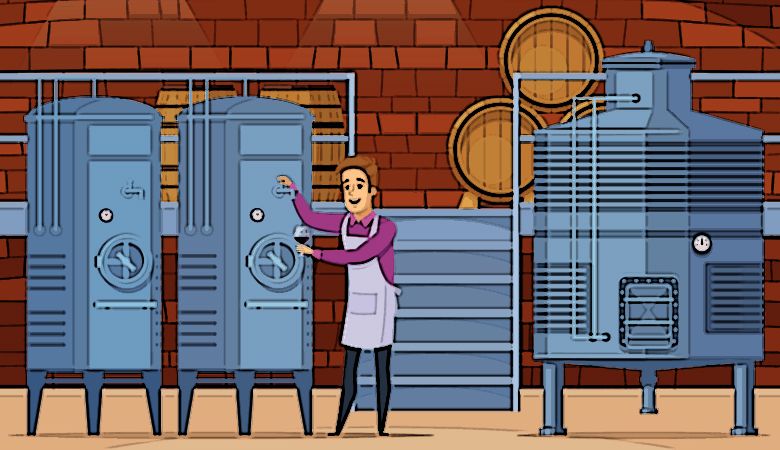Plum of a Job
Winemakers have it made in the shade
By Rusty Gaffney
During 18 years as a wine writer, I’ve discovered many winemakers began their college career paths as pre-med majors. Then, while in college, they found out that winemaking was much less taxing than being a doctor, and they actually could get paid to make wine. Also, they realized that nobody dies if a winemaker screws up, and winemakers get to drink and listen to rock music on the job.
Further investigation revealed winemakers don’t actually make wine, since “wine is made in the vineyard.” Also, they don’t have to do any real work in the vineyard such as pruning, leaf pulling, weed removal, spraying or drive a tractor. They only need to be able to walk the vineyard rows, kick some dirt, taste some grapes and direct the vineyard workers. Many winemakers say, “I try to stay out of the way and let the vineyard speak for itself.” Ron Washam HMW, counters, “What if it’s just a stupid vineyard?”
When winemakers determine the proper time for grapes to be harvested, they don’t pick grapes themselves, but rather engage skilled picking crews to do that work in the early morning hours. The picking decision is the difficult part of being a winemaker. Ross Cobb, winemaker of COBB Wines, agrees, “Beyond what I do in the vineyards, 90% of winemaking is the picking decision.”
Prospective winemakers often attend enology and viticulture school, but here they are primarily taught to be “hands-off” or “non-interventional” in the winery. Others bypass a wine education completely, learning on the job that it is advisable to be a minimalist in the winery and wait or do nothing when a problem arises. Even esteemed wine writers agree. Matt Kramer has espoused, “Those who seek to do less winemaking do seem to accomplish more in the result.”
An often repeated scenario of doing nothing and waiting was described by a notable Pinot Noir winemaker. “One of my strangest experiences that I recall was when I decided to do a 100-percent whole-cluster fermentation with our favorite block of Pinot Noir. The wine was absolutely stunning, from the beginning of fermentation all the way through the end. We would taste the wine each morning in order to decide when to press the wine off the skins. One day we came in, and the wine tasted sour and almost spoiled. It was quite bizarre and scary for a winemaker tasting one of the most expensive blocks of fruit on the property. I decided to press the wine that day and transferred it to barrel the next day. After malolactic fermentation was complete in the spring, and the wine settled down in the cool cellar, I tasted it from barrel, and it was absolutely gorgeous again, even better than it had been in the fermentation tank.”
Winemakers have found that patience and doing less or even doing nothing at all pays off. If an issue does occur that does not correct itself, it is always possible to blame the cellar workers or the enologist.
Harvest only lasts a month or two, so winemakers have 10 months of vacation. After the wines are in barrel, they get to go on expense-paid trips and host fancy wine dinners without picking up the tab. At these lavish dinners, winemakers receive considerable praise about their wines and admiration for the work they do. They collect all the credit while it takes many caring others to do the work.
Winemakers never have to dress for their job. The standard dress is a baseball cap, a vest and boots. Grubbiness is a badge of winemaking acumen. They don’t have to cut their hair, and beards are de rigueur for men. Baths during harvest are optional.
Lunches are a necessary part of the winemaking profession. This is a required collegial, fraternal function where winemakers meet with other winemakers to taste each other’s wines and share winemaking secrets never divulged to consumers. Have you ever visited a wine region, gone to lunch and not seen several winemakers at a nearby table enjoying lunch along with multiple open wine bottles on their table?
Occasionally, a wine critic shows up at the winery to taste the wines. Winemakers learn to easily tackle this situation. They show the critic only the best wines in barrel in the cellar, knowing that “cellar palate” and the winemaker’s camaraderie will invariably enhance the critic’s experience.
Winemakers know to throw around terms like “uncompromising,” “minimum of interference,” “authentic” and “terroir-driven. The same terminology also impresses visiting consumers who are easily mesmerized by winemakers.
The bravest winemakers make Pinot Noir. Pinot Noir is difficult to read because it is a chameleon in the barrel, changing from day to day. It is a finicky grape that can drive a winemaker crazy while challenging a winemaker’s prowess. That said, Pinot Noir is a wine that responds to “hands-off” treatment: no yeast additions, no pumping, no coloring agents, and no fining or filtering. So, Pinot Noir winemakers don’t have to do much. They just let the Pinot Noir grapes make the wine.
Winemaking might be the cushiest job ever.











